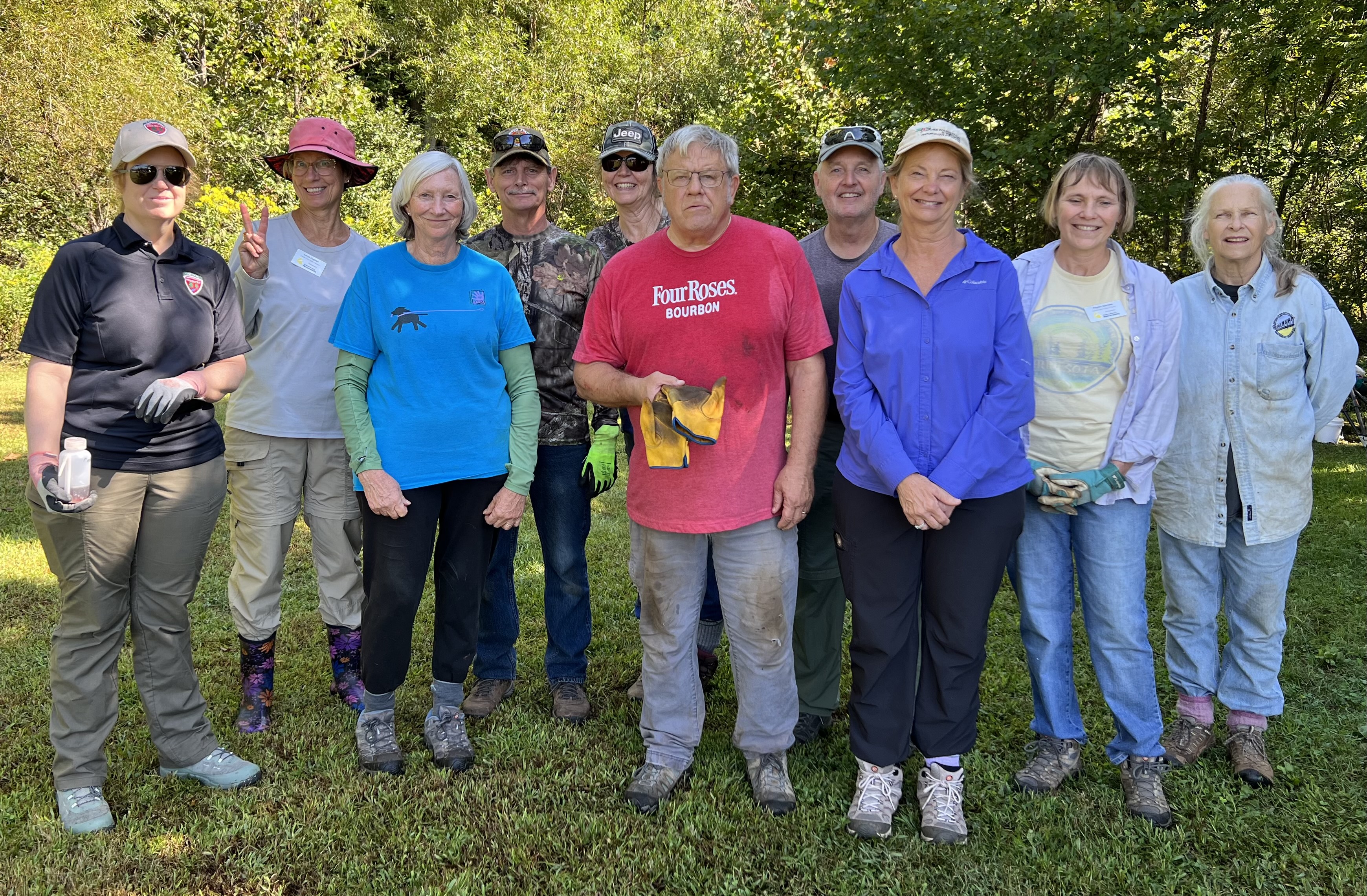
Environmental Literacy Projects on the Rockfish Valley Loop Trails

–Contributed by Mary Voorhees (Rivanna Chapter) and Judy Oglethorpe (Central Blue Ridge Chapter)
The Virginia Department of Conservation and Recreation awarded a grant for an Environmental Literacy (ENLIT) Project to the Rockfish Valley Foundation (RVF) in Nelson County to provide environmental education to the public along the Rockfish Valley Loop trails, part of the Virginia Bird and Wildlife Trail System. On May 2nd, RVF celebrated the completion of this project and formal launch of a) an outdoor education pavilion, b) 18 educational modules with QR codes on a range of topics (including invasive and native plants, geology, birds, stream life and ecology), and c) habitat restoration demonstration sites.
Peter Agelasto, the founder of RVF and a Virginia Master Naturalist volunteer, along with state agency representatives from the Virginia Departments of Conservation and Recreation, Environmental Quality, Forestry, and Wildlife Resources presented at the launch event. Peter provided an overview of the history of RVF and the work that has been completed in collaboration with other agencies since his family placed the land in a conservation easement with the Virginia Outdoors Foundation and opened the trails that were built for public use. State agency representatives discussed their involvement at RVF and in the ENLIT project. Kellie Seaton from DCR said: “I think, absolutely that the ENLIT project is and will be a shining example of a testament to what you can accomplish with those high-quality partnerships and that effective collaboration.” She noted that the project will have a lasting impact “not just on those folks that are using the QR codes and learning something there, but their communities and where they will take that back and all the knowledge they gained.”
Three Virginia Master Naturalists (VMNs)- Mary Voorhees (Rivanna Chapter), Linda Hughes (former member of the Central Blue Ridge Chapter but now with the Historic Rivers Chapter) and Judy Oglethorpe of the Central Blue Ridge Chapter, took the lead to organize habitat restoration workdays and develop signage and modules on invasive and native plants as part of our contribution to this project. Mary and Judy described this work at the May 2nd launch.
Habitat Restoration
We began our efforts in 2023 by collaborating with Blue Ridge PRISM to assess the status of invasives along the trails and develop a management plan. Blue Ridge PRISM also offered a workshop on invasives for the public at RVF in the spring of 2024. We have organized multiple workdays over the past two years at locations along the trails that we prioritized for invasive removal and habitat restoration. Thirty Master Naturalist and community volunteers and four foresters from the Virginia Department of Forestry participated in this work. Most volunteers (16) were from the Central Blue Ridge Chapter.
Our primary demonstration site is the Camille Trailhead, a beautiful riparian area along the Rockfish River and the main entry point to the trails. The area was so overgrown with invasives that you could not view the river. VMN and community volunteers pulled invasive species such as Japanese stiltgrass, garlic mustard, and small Japanese honeysuckle vines by hand. Tree-of-heaven, Bradford pear, multiflora rose, bitterweet and Amur corktree that needed chemical treatment using cut stump or hack and squirt methods were first cut back or hacked by volunteers followed by immediate application of herbicide by certified VDOF pesticide applicators.
Once the invasives were cleared, we held three workdays to plant native trees and shrubs and herbaceous perennials to restore the ecosystem and tackle the reestablishment of invasives. Since the Camille Trailhead is a riparian site, we planted appropriate species such as pawpaw, possumhaw and blackhaw viburnum, winterberry, chokeberry, ninebark, buttonbush, and hazelnut. Wire cages or tubes were installed to prevent deer damage. When the trees or shrubs get larger and are less susceptible to deer damage, they will be removed.
We were excited to find that some native plants such as great blue lobelia, white turtlehead, and purple-stem aster had survived in the understory. We planted more plugs of the lobelia and turtlehead but also added others that would be found in a similar riparian plant community, including Joe-pye weed, Allegheny monkeyflower, white snakeroot, and boneset. This habitat restoration process is ongoing and VMNs and community volunteers will continue to maintain the Camille Trailhead as well as other demonstration sites along the trails where we have been working. These sites include the Glenthorne Loop Traihead, Stillhouse Creek (a stream flowing into the Rockfish River), and a riparian buffer planted by the James River Buffer Program, VDOF.

Invasive and Native Plant Signage and Modules
Mary, Judy, and Linda in collaboration with other organizations obtained signage to add along the trails to educate the public about invasive and native plants. Linda and Mary developed signs with photos and QR codes of the top 12 invasives found along the trails. The QR codes linked to content developed for us by Blue Ridge PRISM about how to identify and control each of these invasive plants. The signs were designed to be moved easily to new locations as invasives are cleared. We have received positive feedback from visitors who noted that they saved the content on their phones to help ID and control invasives on their own property. We also added a sign at the Camille Trailhead to describe the habitat restoration process.
Deya Ramsden, from the Virgina DOF, was able to provide signs for VMNs to install with QR codes for 26 native trees and shrubs. Mary Voorhees and Judy Oglethorpe developed signs and linked content for 10 interesting native plants found at RVF such as skunk cabbage, Dutchman’s breeches, great blue lobelia, and hairy leafcup. Mary and Judy also developed modules with an overview about invasive and native plants that can be accessed via QR code and are located on the ENLIT Loop trail with other modules. We plan to offer school field trips and community events to provide environmental education to students and the community on these important topics.
We are extremely grateful to the Virginia Master Naturalist and community volunteers for their hard work and dedication to making this project a success!